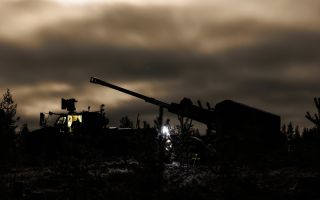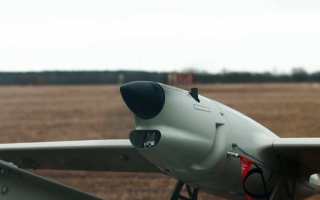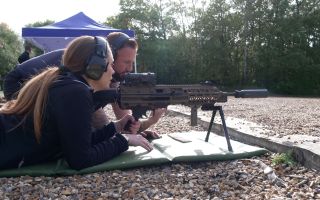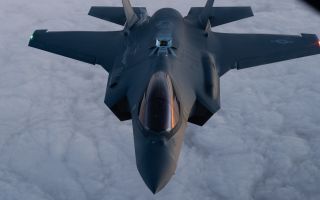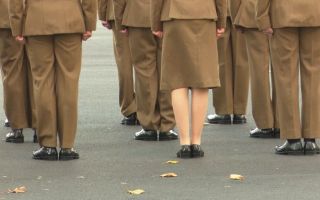Russia are again allegedly bombarding the Syrian city of Aleppo with the ceasefire brokered in New York all but over.
Invited into Syria by the Assad regime the Russian Air Force has deployed some of its most lethal military air power - targeting, officially at least, the rebel and jihadist groups looking to overthrow the government in Damascus.
Below we take a look at some of the aircraft being used in the campaign.
Mi-28 x 2

Picture: Artem Katranzhi
The Mi-28 is a two-seat anti-tank attack helicopter, capable of operating in all weather conditions, day or night. As a dedicated attack helicopter, it has secondary transport capability, unlike the Mi-24 gunship.
It carries a single gun in an undernose barbette, as well as external loads on pylons beneath stub wings.
In April, Russia's Defence Ministry said an Mi-28 had crashed in Syria, killing the two pilots, after completing a mission. It said there was no evidence that it came under fire.
The ministry said the bodies of the pilots were recovered and taken to the Hemeimeem air base on Syria's coast.
Su-24 x 12

Picture: Alexander Mishin
The Su-24 is a supersonic, all-weather attack aircraft/interdictor developed in the Soviet Union and introduced in 1974.
Maximum speed: 815 mph at sea level, 1,027mph at high altitude.
Combat radius: 382 miles, in a low-flying attack mission with 6,615 lb ordnance and external tanks.
Weaponry: Onboard 23 mm GSh-6-23 cannon, 500 rounds of ammunition.
Up to 17,640 lb ordnance, including radio-command missiles, laser-guided missiles, laser/TV-guided short-range air-to-surface missiles, TV-command guided missiles, anti-ship missiles and laser-guided bombs.
Unguided rocket launchers
Other options include general-purpose bombs, thermobaric bombs, cluster bombs, small-size cargo pods, external gun pods, external fuel tanks, and tactical nuclear bombs.
Two air-to-air missiles normally carried for self-defence.
Su-25 x 12

Picture: Vitaly V. Kuzmin
The Su-25 is a single-seat, twin-engine jet introduced in 1981 and designed to provide close air support for the Soviet Union's Ground Forces.
Maximum speed: 606 mph at sea level.
Combat range: 466 miles at sea level, carrying 9,700 lb of weapons and two external tanks.
Guns: GSh-30-2 30mm cannon with 250 rounds.
Rockets: 57 mm or 80 mm rocket pods, 240 mm or 330 mm rockets.
Missiles: Air-to-surface, air-to-air.
Laser-guided bombs.
Mi-24 x 12

Picture: Igor Dvurekov
The Mi24 is a large helicopter gunship, attack helicopter and low-capacity troop transport with space for eight passengers. It's been operational since 1972.
Maximum speed: 208 mph.
Range: 280 miles.
Flexible 12.7 mm Gatling gun on most variants - maximum of 1,470 rounds of ammunition.
Passenger compartment window-mounted machine guns.
Bomb-load: Up to 500 kg.
Submunition/mine dispenser pods.
Gunpod, rocket launchers, anti-tank missiles.
Su-30 x 4

Picture: Alex Beltyukov
The Su-30 is a multirole fighter for all-weather, air-to-air and air-to-surface deep interdiction missions.
Maximum speed: 1,320 mph.
Range: 1,620 nmi at altitude.
Weaponry: One 30mm gun, 150 rounds.
Air-to-air missiles, air-to-surface missiles, anti-radar/ship missiles, laser-guided missiles, cruise missiles.
Aerial bombs including nuclear bombs.
Su-34 x 8
Picture: Dmitry Terekhov
The SU-34 is a twin-engine, twin-seat strike fighter designed to destroy targets at sea, air and on land, including small and mobile ones. It's the cutting edge of Russian military hardware.
It's designed to be capable of performing solo and group missions in daytime and at night, under favourable and adverse weather conditions and in a hostile environment with counter-fire and EW counter-measures deployed, as well as for air reconnaissance.
Maximum speed: High altitude: 1,200 mph.
Low altitude: 870 mph at sea level.
Combat radius: 680 miles at low level altitude.
Weaponry: One 30 mm cannon, 150–180 rounds.
Rockets.
Air-to-air missiles, air-to-ground missiles, some with a range of 40 km, anti-radiation missiles, anti-ship missiles, cruise missiles.
Guided bombs, unguided bombs, cluster bombs, nuclear bombs.
Tu-22M x 14
Picture: Dmitriy Pichugin
The Tu-22M is a supersonic, long-range strategic and maritime strike bomber. It has "swing wings", which can either tuck in or be at right angles to the fuselage mid-flight.
Maximum speed: 1,430 mph.
Range: 4,200 miles.
Combat radius: 1,500 mi with typical weapons load.
Weaponry: 1 × 23-mm cannon in remotely controlled tail turret.
Anti-ship or air-to-surface missiles.
Up to 69 freefall bombs.
6 Tu-95 x 6
Picture: Sergey Krivchikov
The TU-95 is a large, four-engine strategic bomber and missile carrier. It's expected to serve the Russian Air Force until at least 2040, having first flown in 1952.
It's the only propeller-powered strategic bomber still in operational use today. It's also one of the noisiest military aircraft in the world, as the tips of its propeller-blades move faster than the speed of sound.
Maximum speed: 575 mph (reported).
Range: 9,400 miles unrefueled.
Weaponry: Radar-controlled guns.
23mm autocannon in tail turret (Either one or two).
Cruise missiles and anti-ship missiles mounted on underwing pylons.
Tu-160 x 5
Picture: Alex Beltyukov
Maximum speed: 1,380 mph at 40,000 feet.
Cruise speed: 596 mph.
Range: Around 7,643 miles without in-flight refuelling.
Combat radius: 4,536 miles.
Weaponry: Cruise missiles or short-range nuclear missiles.
Su-35 x 4
Picture: Aleksander Markin
The Su-35 is a twin-engine, highly-maneuverable fighter jet first designed in the 1980s.
Maximum speed: At altitude: 1,490 mph
At sea level: 870 mph
Range: At altitude: 1,940 nmi
At sea level: 850 nmi
Weaponry: 30 mm internal cannon with 150 rounds
Rockets including laser-guided and air-to-ground
Missiles including air-to-air, radar homing, air-to-surface, cruise missiles
Laser-guided and unguided bombs
Il-20 x 1
Picture: Kirill Naumenko
A large airliner that first flew in 1957, the Il-20 is currently being used for reconnaissance purposes in Syria. Known as one of the most durable Soviet aircraft of its era, it was one of the world's principal airliners for several decades and was widely exported.
Maximum speed: 419 mph.
Cruising speed: 388 mph at 26,247 feet.
Range: 4,039 miles.
Tu-214 x 1
The Tu-214 is a twin-engined, medium-range, jet airliner capable of carrying 210 passengers. It's also currently being used for reconnaissance missions. First introduced in 1989, it was intended to be similar to the Boeing 757, with slightly lower range and payload.
Cruising speed:500-530 mph.
Maximum speed:560 mph.
Range: (with maximum payload): 2,700 miles.
Mi-8 x 4
Picture: Aleksander Markin
The Mi-8 is a utility helicopter originally designed by the Soviet Union. It's mostly used as a transport helicopter, but can also operate as an airborne command post, armed gunship, and reconnaissance platform.
It's among the world's most-produced helicopters. Used by over 50 countries, it was the third most common operational military aircraft in the world as of last year.
Maximum speed: 161 mph.
Range: 280 miles.
Ferry range: 596 miles.
Weaponry: 57mm rockets, bombs, or anti-tank missiles.
Ka-52 'Alligator' x 2
Picture: Alex Beltyukov
The Ka-52 'Alligator' is a two-seat Russian attack helicopter.
Sporting the distinctive coaxial rotor system of the Kamov design bureau, it's capable of conducting battlefield reconnaissance, providing target designation and supporting and co-ordinating group attack helicopter operations.
Maximum speed: 196 mph.
Range: 339 miles.
Combat radius: 290 miles.
Ferry range: 720 miles.
Weaponry: 30 mm cannon with 460 rounds, ability to carry air-to-air, air-to-ground and anti-tank missiles, as well as bombs, countermeasures, and additional 23 mm gun pods.
Forces TV is available on Sky 264, Virgin 277 and Freesat 652.
















